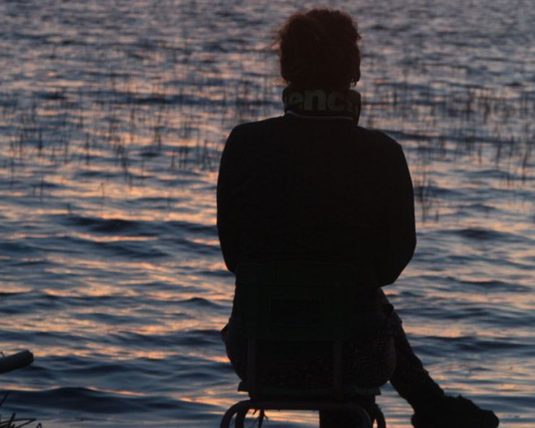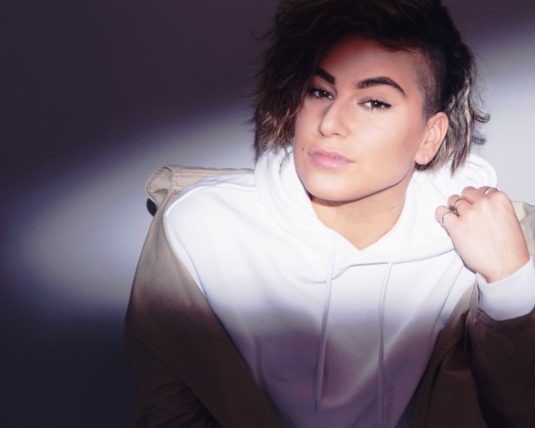Mother-son duo Judy and Cruz Anderson made headlines from coast to coast to coast when they turned street art design into traditional pieces of Indigenous artwork. Think colourful beads, tanned moose hide and graffiti-style letters representing their lived experience as Cree artists in Canada. Below, Kids Help Phone interviews Judy and Cruz on their art and the strength of family relationships. Here, you’ll discover how they weave the two together to maintain their mental, emotional, physical and spiritual well-being.
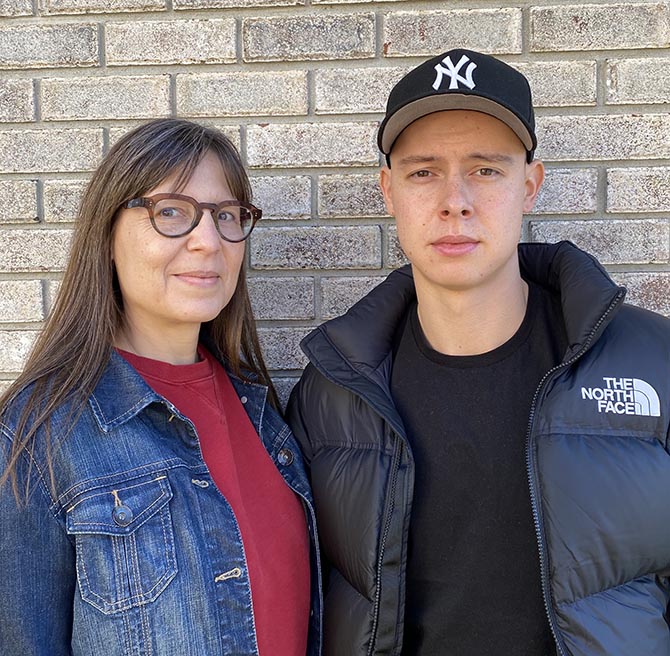
Pictured: Judy and Cruz Anderson
Tell us about yourselves! Where are you from? What other artists are inspiring you right now?
I am especially thankful for the artists who did the hard work to get Indigenous art in the contemporary art scene.
— Judy Anderson
Cruz: My name is Cruz Anderson and I’m an artist from George Gordon First Nation working mostly in traditional techniques of drawing and painting. My inspirations vary between old French paintings from the 19th century, and contemporary Indigenous artists and atelier-trained artists. My contemporary inspirations include Audie Murray, Emmanuel Jarus and Fernando Freitas.
Judy: I am Judy Anderson, Cruz’s mom. I am Nêhiyaw from George Gordon First Nation, Saskatchewan, Treaty 4 territory. I am currently a guest living in Treaty 7 territory on the traditional lands of the Blackfoot Confederacy, the Tsuut’ina First Nation and Stoney Nakoda. The city of Calgary is home to the Métis Nation of Alberta, Region 3.
I am greatly inspired by all Indigenous artists. I am especially thankful for the artists who did the hard work to get Indigenous art in the contemporary art scene. I need to acknowledge my teacher, mentor and friend Ruth Cuthand, the artist who broke ground for contemporary beadwork. The following are a few artists that inspire me: Katherine Boyer, Peter Morin, Hannah Claus, Elwood Jimmy, Carrie Allison, mother-son duo Glenna Cardinal and seth cardinal dodginghorse and the many makers on Instagram.
Tell us about your art — what type of art do you create? Why?
I like to include aspects of my Indigenous identity in my artwork, some of this being Cree words my dad speaks in the house, traditional Indigenous and Métis regalia and elements of Indigenous spirituality.
— Cruz Anderson
Cruz: I like to include aspects of my Indigenous identity in my artwork, some of this being Cree words my dad speaks in the house, traditional Indigenous and Métis regalia and elements of Indigenous spirituality.
Judy: My degrees are in painting, and I naturally work with installation. However, when I worked at the First Nations University of Canada, I wanted to teach the traditional art class. To do this, I had to learn how to bead and quill. I acknowledge my beading teacher Sheila Orr and my quilling teacher Jacob Pratt. After Ruth Cuthand created her Trading Series, she inspired me to work with beads. This is how I created Exploit Robe (Toying Around), where I honour Cruz as a young man and aspiring artist. I primarily bead now, but I am always incorporating installation into the work, and I dream of the paintings I will make when I have time.
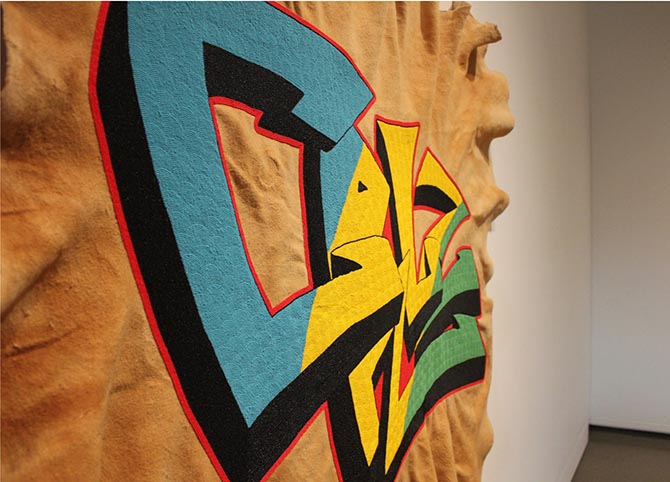
Pictured: Exploit Robe (Toying Around)
Tell us about your relationship! How did you start doing art together? How does doing art together make you feel?
A while back, I fasted. On this fast, I was told, in a spiritual way, that I needed to honour Cruz.
— Judy Anderson
Cruz: I like working with my mom on projects because we are mostly on the same page about issues in the world and concepts in art. I like that we are able to challenge each other’s ideas in an honest way that stimulates our growth as artists.
Judy: A while back, I fasted. On this fast, I was told, in a spiritual way, that I needed to honour Cruz. I have to admit here that I carry some shame at having to be told to look harder at my son to figure out why I was being told to honour him. He was about 10 years old at the time. The best way I knew how to honour him was to make artwork about him. A couple of years later, I decided to honour him and his love of graffiti by beading his first burner (an elaborate graffiti piece) on a traditionally tanned moose hide. Following this, we started collaborating — all of my beaded pieces with graffiti are collaborations with Cruz. Our biggest collaboration was recently installed at the Remai Modern in Saskatoon. It is important to know that the original idea for this collaboration came from Cruz.
I think that Cruz and I have an amazing and close relationship. I am thankful for that message to honour him — it brought us closer together and helped make us better artists. The fast has been instrumental in how I have moved forward in my art practice, and I think it helped foster a practice for Cruz.
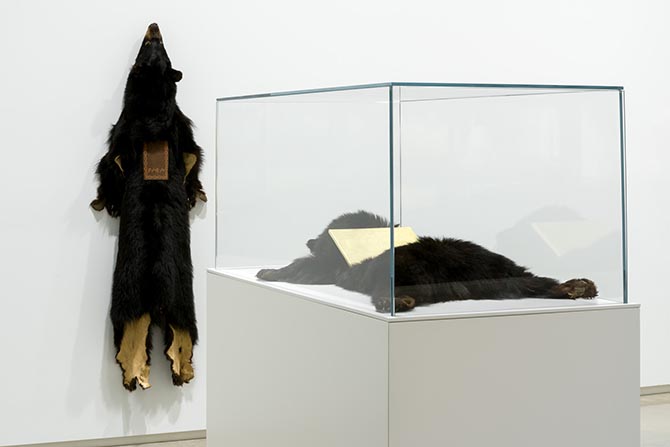
Pictured: I have seen him like this at the Remai Modern
Installation view, borderLINE, 2020, Remai Modern, Saskatoon
Photo credit: Blaine Campbell
How important to you are family relationships, and celebrating those relationships / stories / traditions through art?
I think that personal relationships to family and cultural traditions are often some of the strongest and most intimate bonds we can have.
— Cruz Anderson
Cruz: I think that personal relationships to family and cultural traditions are often some of the strongest and most intimate bonds we can have. Sometimes these relationships come from a place of love, and other times they can harbour negative emotions, but either way I think that the inclusion of these relationships with intimacy often creates the most impactful artworks.
Judy: Family relationships are a top priority. In this, I am also strongly aware of Indigenous concepts of family, which extend beyond the nuclear family. A large part of my practice is done to honour people who are important to me.
How does your relationship and the art you do together affect your mental, emotional, physical and spiritual well-being?
The art I make with Cruz balances me — when we make work together, I feel like the world is in equilibrium.
— Judy Anderson
Cruz: Our artwork often includes our Indigenous traditions and spirituality, so it keeps me grounded. I’ve been living in Toronto for the past few years, so coming home to work on our projects was a nice excuse to visit, too.
Judy: The art I make with Cruz balances me — when we make work together, I feel like the world is in equilibrium. I also want to mention my youngest son, Riel. While we do not make art together, I have made a piece to honour him, This one brings me the most pride. Riel was a large part of this piece — I got approval from him for every part of this piece, and the design on the chin is his. Riel is into drama, music and history.
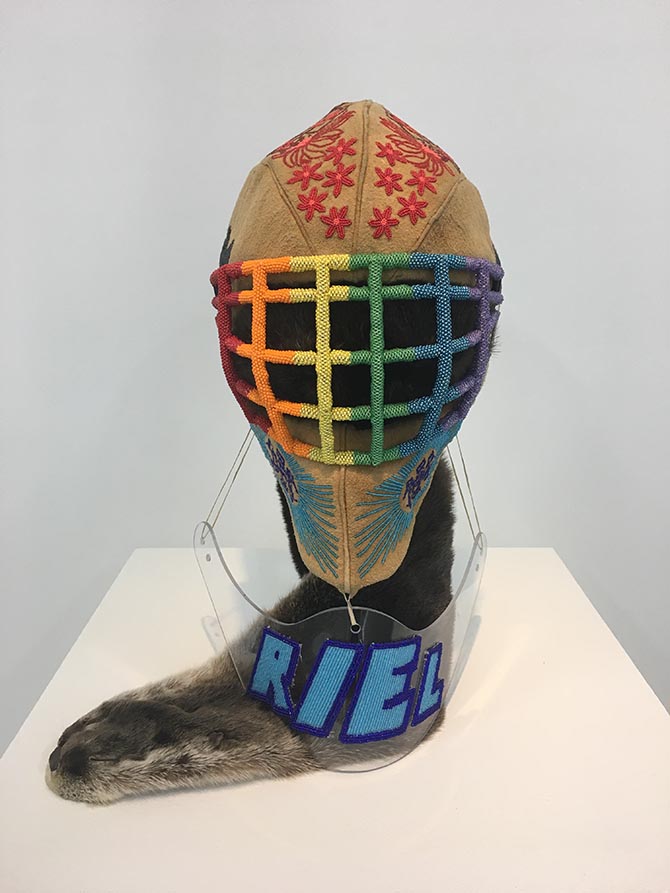
Pictured: This one brings me the most pride
Photo credit: Andrew Barcham
Are there ever times when you have disagreements? How do you handle them?
The most important thing is to apologize when I have wronged him and make sure I am saying things in a way that is not offensive.
— Judy Anderson
Cruz: Usually our disagreements come from mediocre ideas, but we often figure out a way to build on the concepts or incorporate them into another artwork.
Judy: Everyone has disagreements. The most important thing is to apologize when I have wronged him and make sure I am saying things in a way that is not offensive. This is very important to me in all relationships, because we all have the capacity to offend, even if we don’t intend to. Also, I ask for patience from him when I don’t understand what he is saying — the poor guy has to explain things quite often.
What would you say is the most important element of your relationship?
I never want Cruz or Riel to forget the gifts that they bring to this world. Also, to remember we are human, and we make mistakes.— Judy Anderson
Cruz: In our family, we make art sometimes, but we are a family 100% of the time.
Judy: I never want Cruz or Riel to forget the gifts that they bring to this world. Also, to remember we are human, and we make mistakes.
Do you have any tips for youth who’d like to get involved with art? How might they go about getting a relative or friend involved, too?
Throughout my life, I have worried too much about what others think. My biggest advice is: don’t let what others think get in the way of trying what you want.
— Judy Anderson
Cruz: Just try it! Try creating something and see if you like it. Art isn’t just drawing on a piece of paper or painting on canvas. Maybe you’ll like it and pursue a career in it, or maybe it will be something you do with your friends on the weekend. I think everyone is artistic in some way, and I don’t think most artists planned to be artists.
Judy: I am a person who likes to try things. Throughout my life, I have worried too much about what others think. My biggest advice is: don’t let what others think get in the way of trying what you want. And if one thing doesn’t work for you, try another.
Kids Help Phone would like to thank Judy and Cruz Anderson for participating in this story in support of youth mental health and well-being across Canada!

